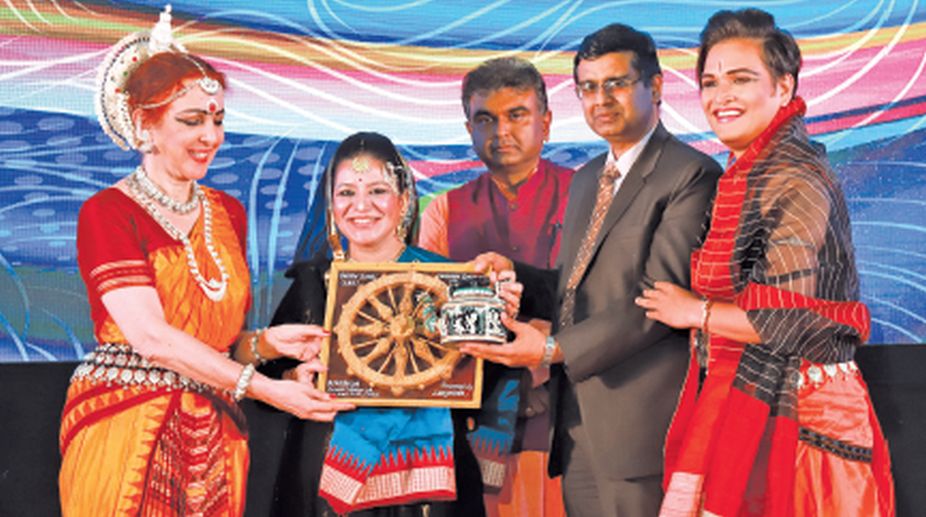Adhering To Tradition
A dance festival organised by Shinjan Nrityalaya focused on gods and goddesses as the central theme.
A festival of classical dance in Dubai, organised by noted exponent, Saswat Joshi, was a veritable treat.

Nishi Singh receiving the Aekalavya Award.
Saswat Joshi, who like the legendary Aekalavya of the Mahabharata, is willing to give his all as guru dakshina to his revered guru, celebrated the 10th edition of his festival at the global Indian International School, Al Barsha in Dubai, with the Indian Consulate playing host.
Hailing from Titlagarh in Balangir district, Odisha, which is not very far away from Sambalpur, Saswat is adept at Sambalpuri folk dance, also known as Dalkhai. He, along with Paris resident Mahina Khanum, danced Sambalpuri group folk dance in front of the Eiffel Tower, in a successful bid to make this rare folk form of Odisha go down the annals of history.
Italian born Ileana Citaristi, who has had a second birth as an Odia, is Saswat’s guru. The festival named Aekalavya is a tribute to the guru shishya paramparawhere knowledge is passed down from the teacher to disciple across generations.
Advertisement
Wherever you find Odias, be sure there will be an Odia Samaj to celebrate Utkal Divas and sing their state anthem, Bande Utkala Janani penned by Kantakabi Laxmikant Mohapatra.
Repertory members of Lasyakala Dance Vision, the school founded by Saswat Joshi, paid their obeisance to Odisha with a beautiful dance to the accompaniment of their state anthem, which described the natural beauty of the place with its flora and fauna.

Young Saswat is a performer, choreographer, teacher and scholar with a difference. Each of the dance pieces presented at the festival blossomed with its unique colour and beauty.
Dasa Mahavidya is a popular number among Odissi dancers but the one presented at the festival by the guru-shishya duo choreographed by Ileana Citaristi, disciple of Guru Kelucharan Mohapatra, was unique.
The piece displayed the sweat and toil that had gone into its perfection. It was educative, just as it was aesthetically appealing. For the Odia diaspora, it was a nostalgic experience of going back to their roots through the medium of their very own Odissi.
Young and bubbly as they are, the performers of Lasyakala danced their signature number Dasavatar or the 10 avatars as visualised by Jaydeva in his inimitable work, the Gita Govinda. The recapturing of the stories of each of the avatars in between the lyric was striking.
One never gets tired of seeing them, such is their eternal beauty. Does anyone get tired of seeing Tchaikovsky’s Swan Lake or Nutcracker? Or for that matter does anyone get tired of seeing Adolph Adam’s Giselle? Dasavatarof Jayadeva’s Gita Govindais an all time favourite. If danced well, it never seizes to be beautiful.
Adeptly combining mythology, history and themes that are secular is the forte of choreographer Saswat Joshi. Kanchi Abhiyanwas the gripping love story of Gajapati Purushottam Deva of Odisha and Padmavati, the princess of Vijaynagar. It was replete with court intrigues, misunderstandings, wars and solving of riddles, before the lovers could unite.
Sutradhars as well as role players switched from one impersonation to the other hassle-free and therein, lay the beauty of the free-flowing and easily comprehensible story, taken from the pages of history, combined with the mythical story of Jagannath’s participation in its wars. The play had mortals and gods playing their roles artfully.
Popular Odia actor Anubha Sourya danced on the theme of Varsha. The usual motifs of the monsoon were captured. The back drop with the picture of nature was well-conceived.
To appreciate the beauty of other classical dance forms of the country Saswat Joshi felicitated and awarded Dubai-based Kathak dancer Nishi Singh and Bharatanatyam dancer Puja Unni with the Aekalavya Samman.

Nishi Singh was remarkable in her abhinaya, Mohe chedo na nandalal—a Bindadin Maharaj thumri. Puja Unni, an accomplished Bharatanatyam dancer’s Kauthuwam, showing the different facets of the Avatar was a treat. Thattu adavus were especially good. However, she could have perhaps avoided polishing her nails in such garish colours.
The ace performer and the young shishya who planned it all, gave the audience a good reason to have remained in their seats for so long. Saswat descended on the stage with the sangita of Jagannath — the lord of the world.
Each and every movement was chiselled to perfection. The shapes were polished while postures and poses were sculpture-like. Ileana Citaristi has emerged as a guru—in the correct sense of the word — and has been bestowed a Padma award by the Government of India.
Her exemplary life as a true Indian, totally dedicated to her guru Kelucharan Mohapatra and successfully passing on the torch to the later generations, is emulative. Possessed with single-minded dedication amounting to devotion, she was an all out devotee of Krishna in her Meera Bhajan.
Without her Krishna, Meera’s condition was akin to that of a bird without a drop of water. The motifs of Meera bhakti were internalised to present the separation of Meera from Krishna.
The chief executive of the historical Orissa Research Centre, Sangita Gosain —where Saswat Joshi had first started his training in Odissi — had accompanied the team to Dubai. She regaled the audience by singing a bunch of songs in her mellifluous voice.
Advertisement